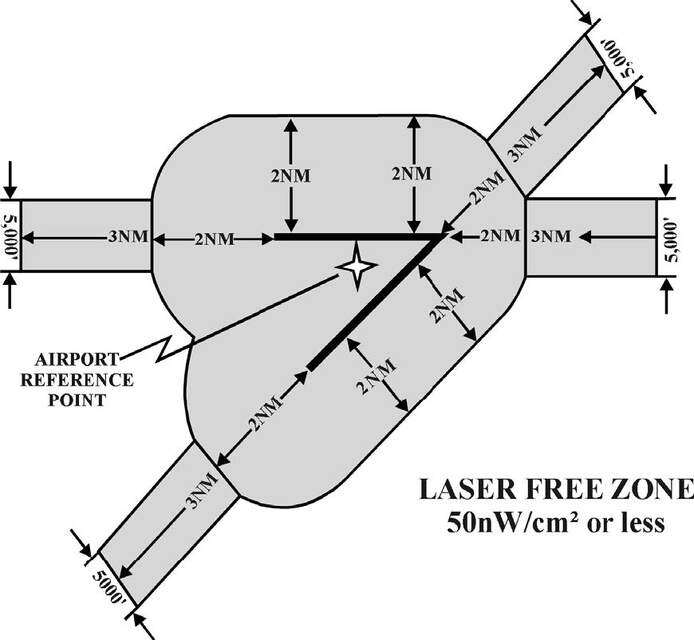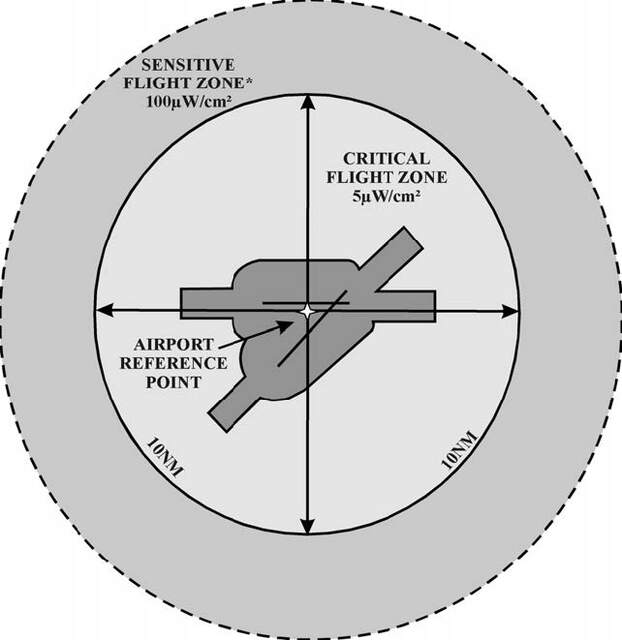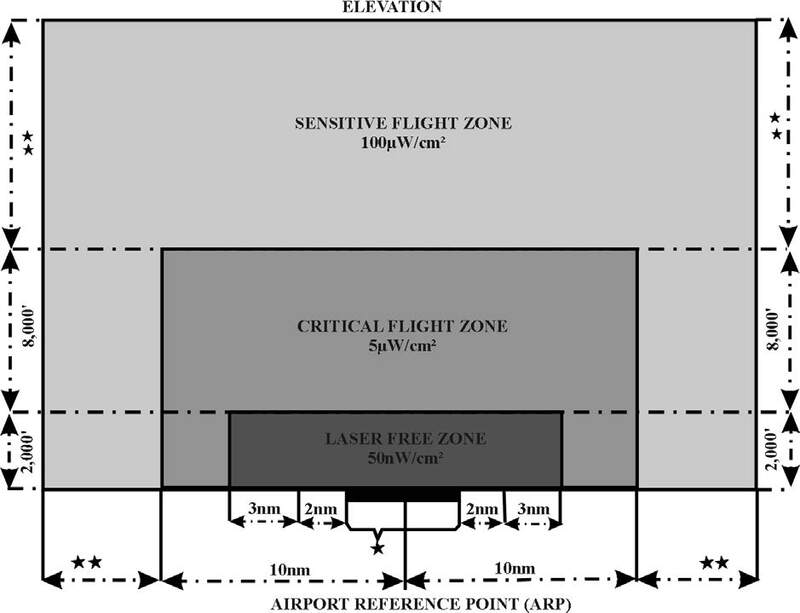Section 1. General
This chapter prescribes policy, responsibilities, and guidelines for processing a Notice of Proposed Outdoor Laser Operation(s) and determining the potential effect of outdoor laser activities on users of the NAS. This includes issuing a determination and providing airmen a notification of the hazard. Determinations should not be issued for laser operations that are terminated and do not enter navigable airspace.
- Title 49 of the U.S. Code (49 U.S.C.), §40103 gives the Administrator the authority to regulate, control, develop plans for, and formulate policies with respect to the use of the navigable airspace.
- Regulatory authority for laser light products has been delegated to the Food and Drug Administration (FDA). Product regulations are detailed in 21 CFR, part 1010, Performance Standards for Electronic Products, and part 1040, Performance Standards for Light Emitting Products.
- Determinations must be based on the findings of an aeronautical review.
- The Service Center Operations Support Group (OSG) having control jurisdiction over the airspace where laser operations are planned must conduct an aeronautical review of all proposed laser operations to be performed in the NAS to ensure that these types of operations will not have a detrimental effect on aircraft operations.
- Full consideration must be given to national defense requirements, commercial uses, and general aviation operations that have the public right of “freedom of transit" through the NAS.
- Accordingly, while a sincere effort must be made to negotiate equitable solutions regarding proposed laser operations in the NAS, preservation of the navigable airspace for aviation must be the primary emphasis.
- The Service Center OSG is responsible for determining the effect of proposed outdoor laser operations on air traffic control operations and issuing a consolidated letter of objection or non-objection. A safety analysis is not required and no determination should be issued, if the laser operation is terminated and all light projections are contained within the venue of the operation and not projected into the NAS.
- The Flight Standards Division, Regional NextGen Branch (RNGB), is responsible for providing a safety analysis to determine any potential effect that a proposed outdoor laser operation would have on flight crews. AFS will designate a RNGB All Weather Operations (AWO) safety inspector for specified geographical areas.
- The office of Aerospace Medicine is responsible for providing information regarding the potential effects of laser beams on pilot vision.
- Afterimage. A reverse contrast shadow image left in the visual field after an exposure to a bright light that may be distracting and disruptive, and may persist for several minutes.
- Center for Devices and Radiological Health (CDRH). An office of the FDA concerned with enforcing compliance with the Federal requirements for laser products including laser light shows.
- Demonstration Laser. Any laser product designed or intended for purposes of visual display of laser beams, for artistic composition, entertainment, and/or advertising display (Reference 21 CFR 1040.10(b) 13). Any demonstration laser in excess of 5 mW requires a variance from the CDRH.
- Divergence. The increase in diameter of the laser beam with distance from the exit aperture. Divergence is an angular measurement of the beam spread, expressed in milliradians (mrad). In laser safety calculations, divergence is defined at the points where the irradiance is 37% of the peak irradiance.
- Flashblindness. Generally, a temporary visual interference effect that persists after the source of illumination has ceased.
- Visual Interference Level. A visible laser beam (normally with an irradiance less than the MPE) that can produce a visual response that interferes with the safe performance of sensitive or critical tasks by air crews or other personnel. This level varies in accordance with the particular zone where the laser is operating. “Visual interference level" is an generic term for critical level, sensitive level, or laser free level.
- Flight Hazard Zones. Airspace areas specifically intended to mitigate the potential hazardous effect of laser radiation. See FIG 29-1-1, FIG 29-1-2, and FIG 29-1-3.
- Glare. Obscuration of an object in a person's field of vision due to a bright light source located near the same line-of sight (e.g., as experienced with oncoming headlights).
- Irradiance. Irradiance is a means of expressing the power of the beam per unit area, expressed in watts per centimeter squared (W/cm2).
- Laser. An acronym for light amplification by stimulated emission of radiation. A laser is a device that produces an intense, directional, coherent beam of visible or invisible light.
- Continuous Wave (CW). The output of a laser which is operated in a continuous duration rather than a pulsed mode.
- Repetitive Pulsed (RP). A laser with multiple pulses of radiant energy occurring in a sequence.
- Laser Manufacturer. A term that refers to persons who make laser products, including those who are engaged in the business of design, assembly, or presentation of a laser light show.
- Laser Operator. A laser operator should be a knowledgeable person present during laser operation who has been given authority to operate the laser system in compliance with applicable safety standards, subject to direction of the laser safety officer.
- Laser Safety Officer (LSO). A designated person who has authority to monitor and enforce the control of laser hazards and affect the evaluation and control of laser hazards.
- Safety Observer. A designated person who is responsible for monitoring the safe operation of a laser and who can immediately terminate the laser beam if necessary to ensure safety. Normally, a safety observer will view airspace in the vicinity of a laser beam to identify any potentially unsafe condition.
- Local Laser Working Group (LLWG). A group that, when necessary, is convened to assist the service area office in evaluating the potential effect of laser beams on aircraft operators in the local vicinity of the proposed laser activity.
- Maximum Permissible Exposure (MPE). The level of laser radiation to which a person may be exposed without hazardous effect or adverse biological change in the eye or skin. In general, MPE is expressed as mW/cm2 or mJ/cm2.
- Nominal Ocular Hazard Distance (NOHD). The distance from the laser system beyond which the laser beam irradiance does not exceed the MPE for that laser.
- Protection Distances. The minimum distance from the laser system beyond which the laser beams irradiance level does not exceed the following specific effective irradiance levels within the corresponding zones:
- Laser Free Zone - 50nW/cm2;
- Critical Zone - 5℞W/cm2;
- Sensitive Zone - 100℞W/cm2;
- Normal Flight Zone - MPE (2.6 mW/cm2 for CW visible lasers).
- Radiant Exposure - A means of expressing the pulse energy of the beam per unit area, expressed as J/cm2.
- Reflections. Reflections can be diffuse or specular.
- Diffuse Reflection. A reflection from a surface, which is incapable of producing a virtual image such as is commonly found with flat finish paints or rough surfaces.
- Specular Reflection. A mirror-like reflection that usually maintains the directional characteristics of the beam.
- Terminated Beam. A laser beam that is blocked from entering navigable airspace.
- Unterminated Beam. A laser beam that is directed or reflected into the navigable airspace.
- Variance. Permission from FDA for a laser manufacturer and/or operator to deviate from one or more requirements of 21 CFR 1040 when alternate steps are taken to provide equivalent level of safety.
- Visible Wavelengths. For the purpose of laser safety, the wavelengths of light that are visible (used for LFZ, CFZ, and SFZ calculations) range from 380 to 780 nanometers (nm).


- Laser Free Zone (LFZ). Airspace in the immediate proximity of the airport, up to and including 2,000 feet AGL, extending 2 NM in all directions measured from the runway centerline. Additionally, the LFZ includes a 3 NM extension, 2,500 feet each side of the extended runway centerline, of each usable runway surface, up to 2,000' AGL of each useable runway surface. The effective irradiance of a visible laser beam is restricted to a level that should not cause any visual distraction or disruption.
- Critical Flight Zone (CFZ). Airspace within a 10 NM radius of the airport reference point, up to and including 10,000 feet AGL. The effective irradiance of a visible laser beam is restricted to a level that should not cause transient visual effects (for example, glare, flashblindness, or afterimage).
- Sensitive Flight Zone (SFZ). Airspace outside the critical flight zones that authorities (e.g., FAA, local departments of aviation, military) identify to be protected from the potential visual effects of laser beams.
- Normal Flight Zones (NFZ). Airspace not defined by the Laser Free, Critical, or Sensitive Flight Zones. As with all the above zones, the NFZ must be protected from a visible or invisible laser beam that exceeds the MPE.

* Runway length varies per airport. AGL is based on published airport elevation
** To be determined by regional/service area office evaluation and/or local airport operations.